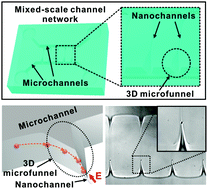Mixed-scale channel networks including Kingfisher-beak-shaped 3D microfunnels for efficient single particle entrapment†
Abstract
Reproducible research results for nanofluidics and their applications require viable fabrication technologies to produce nanochannels integrated with microchannels that can guide fluid flow and analytes into/out of the nanochannels. We present the simple fabrication of mixed-scale polydimethylsiloxane (PDMS) channel networks consisting of nanochannels and microchannels via a single molding process using a monolithic mixed-scale carbon mold. The monolithic carbon mold is fabricated by pyrolyzing a polymer mold patterned by photolithography. During pyrolysis, the polymer mold shrinks by ∼90%, which enables nanosized carbon molds to be produced without a complex nanofabrication process. Because of the good adhesion between the polymer mold and the Si substrate, non-uniform volume reduction occurs during pyrolysis resulting in the formation of curved carbon mold side walls. These curved side walls and the relatively low surface energy of the mold provide efficient demolding of the PDMS channel networks. In addition, the trigonal prismatic shape of the polymer is converted into to a Kingfisher-beak-shaped carbon structure due to the non-uniform volume reduction. The transformation of this mold architecture produces a PDMS Kingfisher-beak-shaped 3D microfunnel that connects the microchannel and the nanochannel smoothly. The smooth reduction in the cross-sectional area of the 3D microfunnels enables efficient single microparticle trapping at the nanochannel entrance; this is beneficial for studies of cell transfection.


 Please wait while we load your content...
Please wait while we load your content...